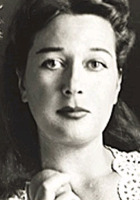Dorothea Tanning
Dorothea Tanning Poems
Be perfect, make it otherwise.
Yesterday is torn in shreds.
Lightning's thousand sulfur eyes
Rip apart the breathing beds.
...
Ever imagining the dire, the sudden
the menace with no thought of the
gradual, the lingering itch of whatever.
That was my sister.
...
If an expatriate is, as I believe, someone
who never forgets for an instant
being one,
then, no.
...
"If it comes to that," he said, "there'll be no
preventing it."
He uttered it as I listened. Had I got it right,
hearing him?
...
Dorothea Tanning Biography
Dorothea Margaret Tanning (August 25, 1910 – January 31, 2012) was an American painter, printmaker, sculptor, writer, and poet. Her early work was influenced by Surrealism. She was also married to fellow Surrealist Max Ernst. Dorothea Tanning was born and raised in Galesburg, Illinois. After attending Knox College for two years (1928–30), she moved to Chicago in 1930 and then to New York in 1935. There she supported herself as a commercial artist while pursuing her own painting, and discovered Surrealism at the Museum of Modern Art’s seminal 1936 exhibition, Fantastic Art, Dada and Surrealism. After an eight-year relationship, she was married briefly to the writer Homer Shannon in 1941. Impressed by her creativity and talent in illustrating fashion advertisements, the art director at Macy’s department store introduced her to the gallery owner Julien Levy, who immediately offered to show her work. Levy later gave Tanning two one-person exhibitions (in 1944 and 1948), and also introduced her to the circle of émigré Surrealists whose work he was showing in his New York gallery, including the German painter Max Ernst. Tanning first met Ernst at a party in 1942. Later he dropped by her studio to consider her work for an exhibition of work by women artists at The Art of This Century gallery, which was owned by Peggy Guggenheim, Ernst's wife at the time. As Tanning recounts in her memoirs, he was enchanted by her iconic self-portrait Birthday (1942, Philadelphia Museum of Art). The two played chess, fell in love, and embarked on a life together that soon took them to Sedona, Arizona, and later to France. They lived in New York for several years before moving to Sedona, where they built a house in the desert landscape, where they hosted visits from many friends crossing the country, including Henri Cartier-Bresson, Lee Miller, Roland Penrose, Yves Tanguy, Kay Sage, Pavel Tchelitchew, George Balanchine, and Dylan Thomas. Tanning and Ernst were married in 1946 in a double wedding with Man Ray and Juliet Browner in Hollywood. In 1949, Tanning and Ernst relocated to France, where they divided their time between Paris and Touraine, returning to Sedona for intervals through the early and mid 1950s. In 1957, they moved to France because Ernst was denied citizenship as a German during the McCarthy era. They remained there together, living in Paris and later Provence, until Ernst's death in 1976, after which Tanning returned to the United States. She continued to create studio art in the 1980s, then turned her attention to her writing and poetry in the 1990s and 2000s, working and publishing until the end of her life. Tanning died on January 31, 2012, at her Manhattan home at age 101.)
The Best Poem Of Dorothea Tanning
All Hallows' Eve
Be perfect, make it otherwise.
Yesterday is torn in shreds.
Lightning's thousand sulfur eyes
Rip apart the breathing beds.
Hear bones crack and pulverize.
Doom creeps in on rubber treads.
Countless overwrought housewives,
Minds unraveling like threads,
Try lipstick shades to tranquilize
Fears of age and general dreads.
Sit tight, be perfect, swat the spies,
Don't take faucets for fountainheads.
Drink tasty antidotes. Otherwise
You and the werewolf: newlyweds.
